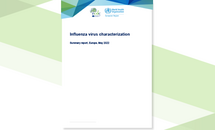Influenza virus characterization - Summary Europe, October 2022
This is the first report for the 2022-2023 influenza season.
Executive Summary
The September 2022 characterization report gave a breakdown of influenza detections across the World Health Organization (WHO) European Region reported to TESSy up to week 39/2022 to complete the 2021–2022 season. This is the first report for the 2022-2023 influenza season. As of week 43/2022, 4 052 detections had been reported, resulting from extended late 2021-2022 season influenza activity. Of these detections, 87% were type A viruses, with A(H3N2) dominating (71%) over A(H1N1)pdm09 (29%), and 13% type B of which 105 were ascribed to a lineage, with all being B/Victoria. This represents a 7-fold increase in detections compared to the 2021-2022 season, despite only a modest increase (3%) in the number of samples tested. While there were clear indications of an influenza epidemic in 2021-2022 with the epidemic threshold of 10% positivity within sentinel specimens having been crossed for 17 weeks, following an approximate two year period of low influenza virus circulation due to the COVID-19 pandemic, indications are that there will be an early start to the 2022-2023 season and a more intense epidemic than in 2021-2022.
Four shipments from countries within the WHO European Region were received at the London WHO Collaborating Centre, the Francis Crick Worldwide Influenza Centre (WIC) since the September report. This report focuses on viruses with collection dates within 2022 for which HA gene sequences were submitted to, and released in, the EpiFlu database of the Global Initiative on Sharing All Influenza Data (GISAID) after September 2022, together with sequences generated and antigenic data determined at the WIC.
Globally relatively few A(H1N1)pdm09 viruses were detected over the course of the 2021-2022 season and the first four weeks of the 2022-2023 season. While the 6B.1A.5a.1 genetic subgroup was dominant in the WHO European Region for most of the last season, 6B.1A.5a.2 viruses have dominated in the first weeks of the 2022-2023 season, coming in line with other WHO Regions. As a percentage of type A viruses detected in the WHO European Region there has been an increase to 29% from 4% in the same period in 2021. Clear antigenic discrimination of 6B.1A.5a.1 and 6B.1A.5a.2 viruses has been shown in many previous reports. A/Victoria/2570/2019-like viruses (6B.1A.5a.2) are being used in vaccines for the northern hemisphere 2022-2023 influenza season. At the September 2022 WHO influenza vaccine composition meeting (VCM) the recommendation was to change the southern hemisphere A(H1N1)pdm09 vaccine virus for the 2023 season to an A/Sydney/5/2021-like virus as recently circulating 6B.1A.5a.2 viruses carry HAI K54Q, A186T, Q189E, E224A, R259K and K308R amino acid substitutions compared to A/Victoria/2570/2019; while such viruses were well recognised by post-infection ferret antisera raised against A/Victoria/2570/2019, they were recognised less well by human post-vaccination sera.
In Europe and across the world A(H3N2) viruses have been dominant with the vast majority of recently detected viruses falling in the ‘Bangladesh-like’ (3C.2a1b.2a.2) subgroup of late. While clusters of viruses showing antigenic drift have emerged among the ‘Bangladesh-like’ viruses, the great majority of these viruses retained good recognition by post-infection ferret antisera raised against egg-propagated A/Darwin/9/2021 which has been recommended for egg-based vaccines to be used in the 2022 and 2023 southern hemisphere, and 2022-23 northern hemisphere seasons. Antisera raised against a range of cell culture- and egg-propagated 3C.2a1b.2a.2 viruses generally gave good recognition of the nine 3C.2a1b.2a.2 test viruses analysed here and those analysed previously.
In Europe and across the world generally, few B/Victoria-lineage viruses have been detected during weeks 40-43/2022. All fall within subclade V1A.3 represented by B/Washington/02/2019, the vaccine virus recommended for inclusion in influenza vaccines for the 2021-2022 northern hemisphere season. A large majority of HA sequences from these viruses, in geographically dispersed countries, have fallen in the V1A.3a group defined by a series of HA1 amino acid substitutions including N150K, with most falling in the V1A.3a.2 subgroup with defining HA1 A127T, P144L and K203R amino acid substitutions. B/Austria/1359417/2021-like (V1A.3a.2) viruses have been recommended for use in the southern hemisphere 2022 and 2023, and the northern hemisphere 2022-2023 influenza seasons. Of the V1A.3 virus cluster that emerged and spread in the Netherlands, which showed poor recognition by the panel of post-infection ferret antisera used at the WIC, a second detection in Spain has been reported. In addition, viruses detected in August in Guatemala and Zambia form separate V1A.3 clusters defined by specific HA1 amino acid substitutions.
No cases of infection with circulating B/Yamagata-lineage viruses have been confirmed since March of
2020. All HA gene sequences from the 77 viruses detected in 2020, inclusive of 16 from the WHO
European Region, belonged to genetic clade Y3 and had three HA1 amino acid substitutions (L172Q,
D229N and M251V) compared to B/Phuket/3073/2013-like viruses which are still recommended for use in quadrivalent influenza vaccines. There is need to share all B/Yamagata-lineage viruses detected
recently for detailed characterization to determine if there are any in circulation that are not related
to Live Attenuated Influenza Vaccines.
Download








